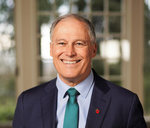

New guidance on reopening in-person instruction in K-12 schools in Washington intends to implement recent data that shows transmission of COVID-19 in school buildings is limited as long as health and safety standards are put in place.
During a press conference Dec. 16, Gov. Jay Inslee announced the new guidance, which reworks the tiers the state recommends to local school districts on when phasing-in school reopenings should happen. Inslee said that given the information and science available, as well as successful reopening attempts in some schools across the state, “it is time to begin the process of getting more of our students back into the classroom.”
Under the new guidelines, in-person learning for all K-12 students is recommended for areas with fewer than 50 cases per 100,000 of population in the past 14 days. Areas between 50 and 350 cases per 100,000 are recommended to phase in-person learning for elementary and middle school students, while those with more than 350 cases per 100,000 recommended to bring back elementary students and those with the highest needs in small groups of about 15 per group.
Inslee said currently only about 15 percent of K-12 students are receiving any form of in-person learning. He said that although there had been COVID-19 transmission in schools, the number of cases was low, even in counties where outside virus activity was high.
Inslee presented a graph that showed little difference in the reproductive numbers, which show how many additional infections occur per an initial one, in various scenarios of reopening as long as health and safety measures were in place.
Washington State Assistant Secretary of Health Lacy Fehrenbach said that although data showed there were more outbreaks in schools that had reopened in higher-activity areas, half of the outbreaks involved three or fewer cases. She added other data showing that where COVID-19 case rates were stable or decreasing, reopening schools did not impact community transmission.
Fehrenbach said that for districts that have already begun in-person learning, it was not recommended that they revert back to remote learning if their areas began to see increases, so long as they could prevent transmission in schools.
Inslee reiterated that the decision to reopen schools remained at the discretion of local districts and would not be mandated by the state. Though the choice to reopen was up to local districts, those that did so would be required by the state to follow the health and safety measures, he said, which included symptom screening, physical distancing, use of facial coverings and increased hygiene and cleaning.
The governor said that he had instructed the Washington State Department of Labor and Industries to designate a single point of contact to serve as a liaison for school workplace safety questions and concerns, adding that concerns brought up could lead to enhanced inspections.
To aid in school reopening, Inslee said he directed $3 million in federal CARES Act funds for safety planning in school districts. In a release discussing the new guidelines, the governor’s office stated that money would be used to help fund third-party audits and support staff in districts that need more funding to meet the new safety requirements.
Inslee and other speakers at the press conference acknowledged that in-person instruction was critical for the student population outside of just providing education. Seattle Children’s Hospital Chief of Pediatric Infectious Diseases Danielle Zerr noted the importance of social interactions for the youngest students, and that remote learning wasn’t able to meet their developmental needs.
Remote learning has also taken a toll on the well-being of older students. Zerr said data showed older students ages 11 to 17 had been more likely than other age groups to have moderate to severe symptoms of anxiety and depression, adding that a September study showed over half of 11 to 17-year-olds reported that they had thoughts of suicide or self-harm every nearly day in the prior two weeks.
Inslee, Zerr and other speakers acknowledged that there was no situation of in-person learning with zero risk of COVID-19 transmission, but the health and safety measures put in place through the guidelines reduced the risk enough to begin the transition back into classrooms.
“While nothing is without risk, kids can be brought back to schools in-person safely through careful preparation and thoughtful sequencing appropriate to disease burden in the community, age of the students and other considerations,” Zerr said.